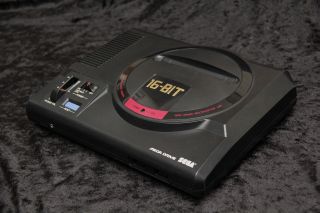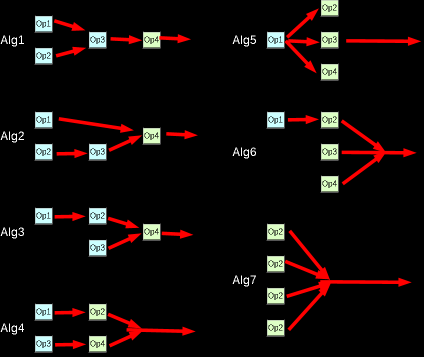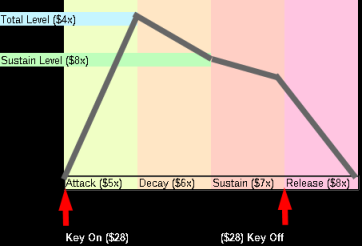Reg
|
Purpose |
A0/D0
$4000/1
$A04000/1
|
A1/D1
$4002/3
$A04002/3
|
Bits |
Details |
| $22 |
LFO |
ALL |
- |
----EFFF |
E=enable
F=frequency |
| $24 |
Timer A low |
ALL |
- |
TTTTTTTT |
Timer bits
10-2 |
| $25 |
Timer A high |
ALL |
- |
------TT |
Timer bits
1-0 |
| $26 |
Timer B |
ALL |
- |
TTTTTTTT |
Timer B |
| $27 |
Ch3 CSM Mode
& Ch3 Multi-Mode & Enable Timers |
ALL |
- |
33RROOSS |
3= Chn 3 mode
/ R=timer resets / O= Timer overflows / S = Timer StartStop |
| $28 |
Individual
Operator Key On/Off |
ALL |
- |
OOOO-CCC |
O=operator
(%4321----) / C=Channel (%000=chn 1 %110=chn6) |
| $29 |
SCH, IRQ
Enable |
ALL |
- |
S--IIIII |
S=Sixchannel
/ I=IRQ Enable |
| $2A |
DAC Write |
ALL |
- |
DDDDDDDD |
D=Data |
| $2B |
DAC Enable |
ALL |
- |
E------- |
E=enable |
| $30 |
Multiplier
& Detune |
Ch1 Op1 |
Ch4 Op1 |
-DDDMMMM |
D=Detune /
M=Multiplier |
| $31 |
Multiplier
& Detune |
Ch2 Op1 |
Ch5 Op1 |
-DDDMMMM |
D=Detune /
M=Multiplier |
| $32 |
Multiplier
& Detune |
Ch3 Op1 |
Ch6 Op1 |
-DDDMMMM |
D=Detune /
M=Multiplier |
| $34 |
Multiplier
& Detune |
Ch1 Op2 |
Ch4 Op2 |
-DDDMMMM |
D=Detune /
M=Multiplier |
| $35 |
Multiplier
& Detune |
Ch2 Op2 |
Ch5 Op2 |
-DDDMMMM |
D=Detune /
M=Multiplier |
| $36 |
Multiplier
& Detune |
Ch3 Op2 |
Ch6 Op2 |
-DDDMMMM |
D=Detune /
M=Multiplier |
| $38 |
Multiplier
& Detune |
Ch1 Op3 |
Ch4 Op3 |
-DDDMMMM |
D=Detune /
M=Multiplier |
| $39 |
Multiplier
& Detune |
Ch2 Op3 |
Ch5 Op3 |
-DDDMMMM |
D=Detune /
M=Multiplier |
| $3A |
Multiplier
& Detune |
Ch3 Op3 |
Ch6 Op3 |
-DDDMMMM |
D=Detune /
M=Multiplier |
| $3C |
Multiplier
& Detune |
Ch1 Op4 |
Ch4 Op4 |
-DDDMMMM |
D=Detune /
M=Multiplier |
| $3D |
Multiplier
& Detune |
Ch2 Op4 |
Ch5 Op4 |
-DDDMMMM |
D=Detune /
M=Multiplier |
| $3E |
Multiplier
& Detune |
Ch3 Op4 |
Ch6 Op4 |
-DDDMMMM |
D=Detune /
M=Multiplier |
| $40 |
Total Level |
Ch1 Op1 |
Ch4 Op1 |
-TTTTTTT |
T=Total Level
(0=largest) |
| $41 |
Total Level |
Ch2 Op1 |
Ch5 Op1 |
-TTTTTTT |
T=Total Level
(0=largest) |
| $42 |
Total Level |
Ch3 Op1 |
Ch6 Op1 |
-TTTTTTT |
T=Total Level
(0=largest) |
| $44 |
Total Level |
Ch1 Op2 |
Ch4 Op2 |
-TTTTTTT |
T=Total Level
(0=largest) |
| $45 |
Total Level |
Ch2 Op2 |
Ch5 Op2 |
-TTTTTTT |
T=Total Level
(0=largest) |
| $46 |
Total Level |
Ch3 Op2 |
Ch6 Op2 |
-TTTTTTT |
T=Total Level
(0=largest) |
| $48 |
Total Level |
Ch1 Op3 |
Ch4 Op3 |
-TTTTTTT |
T=Total Level
(0=largest) |
| $49 |
Total Level |
Ch2 Op3 |
Ch5 Op3 |
-TTTTTTT |
T=Total Level
(0=largest) |
| $4A |
Total Level |
Ch3 Op3 |
Ch6 Op3 |
-TTTTTTT |
T=Total Level
(0=largest) |
| $4C |
Total Level |
Ch1 Op4 |
Ch4 Op4 |
-TTTTTTT |
T=Total Level
(0=largest) |
| $4D |
Total Level |
Ch2 Op4 |
Ch5 Op4 |
-TTTTTTT |
T=Total Level
(0=largest) |
| $4E |
Total Level |
Ch3 Op4 |
Ch6 Op4 |
-TTTTTTT |
T=Total Level
(0=largest) |
| $50 |
Attack Rate
& Rate Key Scaling |
Ch1 Op1 |
Ch4 Op1 |
RR-AAAAA |
R=Rate
Scaling / A = Attack rate |
| $51 |
Attack Rate
& Rate Key Scaling |
Ch2 Op1 |
Ch5 Op1 |
RR-AAAAA |
R=Rate
Scaling / A = Attack rate |
| $52 |
Attack Rate
& Rate Key Scaling |
Ch3 Op1 |
Ch6 Op1 |
RR-AAAAA |
R=Rate
Scaling / A = Attack rate |
| $54 |
Attack Rate
& Rate Key Scaling |
Ch1 Op2 |
Ch4 Op2 |
RR-AAAAA |
R=Rate
Scaling / A = Attack rate |
| $55 |
Attack Rate
& Rate Key Scaling |
Ch2 Op2 |
Ch5 Op2 |
RR-AAAAA |
R=Rate
Scaling / A = Attack rate |
| $56 |
Attack Rate
& Rate Key Scaling |
Ch3 Op2 |
Ch6 Op2 |
RR-AAAAA |
R=Rate
Scaling / A = Attack rate |
| $58 |
Attack Rate
& Rate Key Scaling |
Ch1 Op3 |
Ch4 Op3 |
RR-AAAAA |
R=Rate
Scaling / A = Attack rate |
| $59 |
Attack Rate
& Rate Key Scaling |
Ch2 Op3 |
Ch5 Op3 |
RR-AAAAA |
R=Rate
Scaling / A = Attack rate |
| $5A |
Attack Rate
& Rate Key Scaling |
Ch3 Op3 |
Ch6 Op3 |
RR-AAAAA |
R=Rate
Scaling / A = Attack rate |
| $5C |
Attack Rate
& Rate Key Scaling |
Ch1 Op4 |
Ch4 Op4 |
RR-AAAAA |
R=Rate
Scaling / A = Attack rate |
| $5D |
Attack Rate
& Rate Key Scaling |
Ch2 Op4 |
Ch5 Op4 |
RR-AAAAA |
R=Rate
Scaling / A = Attack rate |
| $5E |
Attack Rate
& Rate Key Scaling |
Ch3 Op4 |
Ch6 Op4 |
RR-AAAAA |
R=Rate
Scaling / A = Attack rate |
| $60 |
Decay Rate
& AM Enable |
Ch1 Op1 |
Ch4 Op1 |
A--DDDDD |
A=Amplitude
Mod Enable / D= Decay rate |
| $61 |
Decay Rate
& AM Enable |
Ch2 Op1 |
Ch5 Op1 |
A--DDDDD |
A=Amplitude
Mod Enable / D= Decay rate |
| $62 |
Decay Rate
& AM Enable |
Ch3 Op1 |
Ch6 Op1 |
A--DDDDD |
A=Amplitude
Mod Enable / D= Decay rate |
| $64 |
Decay Rate
& AM Enable |
Ch1 Op2 |
Ch4 Op2 |
A--DDDDD |
A=Amplitude
Mod Enable / D= Decay rate |
| $65 |
Decay Rate
& AM Enable |
Ch2 Op2 |
Ch5 Op2 |
A--DDDDD |
A=Amplitude
Mod Enable / D= Decay rate |
| $66 |
Decay Rate
& AM Enable |
Ch3 Op2 |
Ch6 Op2 |
A--DDDDD |
A=Amplitude
Mod Enable / D= Decay rate |
| $68 |
Decay Rate
& AM Enable |
Ch1 Op3 |
Ch4 Op3 |
A--DDDDD |
A=Amplitude
Mod Enable / D= Decay rate |
| $69 |
Decay Rate
& AM Enable |
Ch2 Op3 |
Ch5 Op3 |
A--DDDDD |
A=Amplitude
Mod Enable / D= Decay rate |
| $6A |
Decay Rate
& AM Enable |
Ch3 Op3 |
Ch6 Op3 |
A--DDDDD |
A=Amplitude
Mod Enable / D= Decay rate |
| $6C |
Decay Rate
& AM Enable |
Ch1 Op4 |
Ch4 Op4 |
A--DDDDD |
A=Amplitude
Mod Enable / D= Decay rate |
| $6D |
Decay Rate
& AM Enable |
Ch2 Op4 |
Ch5 Op4 |
A--DDDDD |
A=Amplitude
Mod Enable / D= Decay rate |
| $6E |
Decay Rate
& AM Enable |
Ch3 Op4 |
Ch6 Op4 |
A--DDDDD |
A=Amplitude
Mod Enable / D= Decay rate |
| $70 |
Sustain Rate |
Ch1 Op1 |
Ch4 Op1 |
---SSSSS |
S=Sustain
Rate |
| $71 |
Sustain Rate |
Ch2 Op1 |
Ch5 Op1 |
---SSSSS |
S=Sustain
Rate |
| $72 |
Sustain Rate |
Ch3 Op1 |
Ch6 Op1 |
---SSSSS |
S=Sustain
Rate |
| $74 |
Sustain Rate |
Ch1 Op2 |
Ch4 Op2 |
---SSSSS |
S=Sustain
Rate |
| $75 |
Sustain Rate |
Ch2 Op2 |
Ch5 Op2 |
---SSSSS |
S=Sustain
Rate |
| $76 |
Sustain Rate |
Ch3 Op2 |
Ch6 Op2 |
---SSSSS |
S=Sustain
Rate |
| $78 |
Sustain Rate |
Ch1 Op3 |
Ch4 Op3 |
---SSSSS |
S=Sustain
Rate |
| $79 |
Sustain Rate |
Ch2 Op3 |
Ch5 Op3 |
---SSSSS |
S=Sustain
Rate |
| $7A |
Sustain Rate |
Ch3 Op3 |
Ch6 Op3 |
---SSSSS |
S=Sustain
Rate |
| $7C |
Sustain Rate |
Ch1 Op4 |
Ch4 Op4 |
---SSSSS |
S=Sustain
Rate |
| $7D |
Sustain Rate |
Ch2 Op4 |
Ch5 Op4 |
---SSSSS |
S=Sustain
Rate |
| $7E |
Sustain Rate |
Ch3 Op4 |
Ch6 Op4 |
---SSSSS |
S=Sustain
Rate |
| $80 |
Release Rate
& Sustain Level |
Ch1 Op1 |
Ch4 Op1 |
SSSSRRRR |
S=Sustain
Level / Release Rate |
| $81 |
Release Rate
& Sustain Level |
Ch2 Op1 |
Ch5 Op1 |
SSSSRRRR |
S=Sustain
Level / Release Rate |
| $82 |
Release Rate
& Sustain Level |
Ch3 Op1 |
Ch6 Op1 |
SSSSRRRR |
S=Sustain
Level / Release Rate |
| $84 |
Release Rate
& Sustain Level |
Ch1 Op2 |
Ch4 Op2 |
SSSSRRRR |
S=Sustain
Level / Release Rate |
| $85 |
Release Rate
& Sustain Level |
Ch2 Op2 |
Ch5 Op2 |
SSSSRRRR |
S=Sustain
Level / Release Rate |
| $86 |
Release Rate
& Sustain Level |
Ch3 Op2 |
Ch6 Op2 |
SSSSRRRR |
S=Sustain
Level / Release Rate |
| $88 |
Release Rate
& Sustain Level |
Ch1 Op3 |
Ch4 Op3 |
SSSSRRRR |
S=Sustain
Level / Release Rate |
| $89 |
Release Rate
& Sustain Level |
Ch2 Op3 |
Ch5 Op3 |
SSSSRRRR |
S=Sustain
Level / Release Rate |
| $8A |
Release Rate
& Sustain Level |
Ch3 Op3 |
Ch6 Op3 |
SSSSRRRR |
S=Sustain
Level / Release Rate |
| $8C |
Release Rate
& Sustain Level |
Ch1 Op4 |
Ch4 Op4 |
SSSSRRRR |
S=Sustain
Level / Release Rate |
| $8D |
Release Rate
& Sustain Level |
Ch2 Op4 |
Ch5 Op4 |
SSSSRRRR |
S=Sustain
Level / Release Rate |
| $8E |
Release Rate
& Sustain Level |
Ch3 Op4 |
Ch6 Op4 |
SSSSRRRR |
S=Sustain
Level / Release Rate |
| $90 |
SSG-Envelope
Generator |
Ch1 Op1 |
Ch4 Op1 |
----EEEE |
E=Envelope
Gen |
| $91 |
SSG-Envelope
Generator |
Ch2 Op1 |
Ch5 Op1 |
----EEEE |
E=Envelope
Gen |
| $92 |
SSG-Envelope
Generator |
Ch3 Op1 |
Ch6 Op1 |
----EEEE |
E=Envelope
Gen |
| $94 |
SSG-Envelope
Generator |
Ch1 Op2 |
Ch4 Op2 |
----EEEE |
E=Envelope
Gen |
| $95 |
SSG-Envelope
Generator |
Ch2 Op2 |
Ch5 Op2 |
----EEEE |
E=Envelope
Gen |
| $96 |
SSG-Envelope
Generator |
Ch3 Op2 |
Ch6 Op2 |
----EEEE |
E=Envelope
Gen |
| $98 |
SSG-Envelope
Generator |
Ch1 Op3 |
Ch4 Op3 |
----EEEE |
E=Envelope
Gen |
| $99 |
SSG-Envelope
Generator |
Ch2 Op3 |
Ch5 Op3 |
----EEEE |
E=Envelope
Gen |
| $9A |
SSG-Envelope
Generator |
Ch3 Op3 |
Ch6 Op3 |
----EEEE |
E=Envelope
Gen |
| $9C |
SSG-Envelope
Generator |
Ch1 Op4 |
Ch4 Op4 |
----EEEE |
E=Envelope
Gen |
| $9D |
SSG-Envelope
Generator |
Ch2 Op4 |
Ch5 Op4 |
----EEEE |
E=Envelope
Gen |
| $9E |
SSG-Envelope
Generator |
Ch3 Op4 |
Ch6 Op4 |
----EEEE |
E=Envelope
Gen |
| $A0 |
Frequency low
(Write Second) |
Ch1 |
Ch4 |
PPPPPPPP |
P=Frequency
Position L |
| $A1 |
Frequency low
(Write Second) |
Ch2 |
Ch5 |
PPPPPPPP |
P=Frequency
Position L |
| $A2 |
Frequency low
(Write Second) |
Ch3 |
Ch6 |
PPPPPPPP |
P=Frequency
Position L |
| $A4 |
Frequency
high & Octave (Write first) |
Ch1 |
Ch4 |
--OOOPPP |
O=Octive /
P=Position H |
| $A5 |
Frequency
high & Octave (Write first) |
Ch2 |
Ch5 |
--OOOPPP |
O=Octive /
P=Position H |
| $A6 |
Frequency
high & Octave (Write first) |
Ch3 |
Ch6 |
--OOOPPP |
O=Octive /
P=Position H |
| $A8 |
Frequency low
during Multi-Mode |
Ch3 Op2 |
- |
PPPPPPPP |
P=Frequency
Position L |
| $A9 |
Frequency low
during Multi-Mode |
Ch3 Op3 |
- |
PPPPPPPP |
P=Frequency
Position L |
| $AA |
Frequency low
during Multi-Mode |
Ch3 Op4 |
- |
PPPPPPPP |
P=Frequency
Position L |
| $AC |
Frequency
high & Octave during Multi-Mode |
Ch3 Op2 |
- |
--OOOPPP |
O=Octive /
P=Position H |
| $AD |
Frequency
high & Octave during Multi-Mode |
Ch3 Op3 |
- |
--OOOPPP |
O=Octive /
P=Position H |
| $AE |
Frequency
high & Octave during Multi-Mode |
Ch3 Op4 |
- |
--OOOPPP |
O=Octive /
P=Position H |
| $B0 |
Algorithm
& Feedback |
Ch1 |
Ch4 |
--FFFAAA |
F=Feedback /
A=Algorithm |
| $B1 |
Algorithm
& Feedback |
Ch2 |
Ch5 |
--FFFAAA |
F=Feedback /
A=Algorithm |
| $B2 |
Algorithm
& Feedback |
Ch3 |
Ch6 |
--FFFAAA |
F=Feedback /
A=Algorithm |
| $B4 |
FMS & AMS
& Stereo |
Ch1 |
Ch4 |
LRAA-FFF |
Left / Right
(1=on) / A=Amplitude Mod Sensitivity / F=Frequency Mod Sensitivity |
| $B5 |
FMS & AMS
& Stereo |
Ch2 |
Ch5 |
LRAA-FFF |
Left / Right
(1=on) / A=Amplitude Mod Sensitivity / F=Frequency Mod Sensitivity |
| $B6 |
FMS & AMS
& Stereo |
Ch3 |
Ch6 |
LRAA-FFF |
Left / Right
(1=on) / A=Amplitude Mod Sensitivity / F=Frequency Mod Sensitivity |




